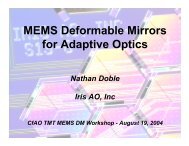PSF reconstruction for Keck AO - Laboratory for Adaptive Optics
PSF reconstruction for Keck AO - Laboratory for Adaptive Optics
PSF reconstruction for Keck AO - Laboratory for Adaptive Optics
Create successful ePaper yourself
Turn your PDF publications into a flip-book with our unique Google optimized e-Paper software.
1 INTRODUCTION 31 IntroductionThis document collects and summarizes the work done to date within the framework of the Cf<strong>AO</strong> funded project“<strong>PSF</strong> <strong>reconstruction</strong> at WMKO: Development, implementation and validation of <strong>PSF</strong> <strong>reconstruction</strong> techniques,”initially funded <strong>for</strong> FY09. <strong>PSF</strong> <strong>reconstruction</strong> is planned to be an additional resource <strong>for</strong> astronomers observing withadaptive optics (<strong>AO</strong>). The point spread function (<strong>PSF</strong>) of <strong>AO</strong> observations can have a complex structure, making itsestimation and modeling hard <strong>for</strong> the non-expert (and, it is fair to say, also <strong>for</strong> the expert). The recent availabilityof recorded real-time <strong>AO</strong> telemetry data such as wavefront sensor (WFS) centroids and sub-aperture intensities, bythe capacity introduced by a new wavefront controller (WFC), makes realistic <strong>PSF</strong> estimation more feasible.1.1 Project summaryThis section is a summary of the goals, current status and future schedule of the multi-year collaborative proposal[1] to the Cf<strong>AO</strong> “Development, implementation and validation of <strong>PSF</strong> <strong>reconstruction</strong> techniques.” (This sectionwas originally presented as the Y9 Cf<strong>AO</strong> project annual report, April 2008, LeMignant & Flicker.) The projectstarted in November 2007 at the W. M. <strong>Keck</strong> Observatory (WMKO) under the direction of D. Le Mignant (PI), withpostdoctoral researcher R. Flicker employed <strong>for</strong> the principal algorithm development and implementation.Project milestonesThe proposal outlined three major phases of the project, described in roughly chronological order as:1. Initial development phase; on-axis NGS only (8 months)a. Review previous research on <strong>PSF</strong> <strong>reconstruction</strong> and select candidate algorithmsb. Develop K2 <strong>AO</strong> simulation tools <strong>for</strong> the purpose of producing simulated <strong>AO</strong> telemetry datac. Develop TRS (telemetry recorder/server) query and analysis toolsd. Develop prototype <strong>PSF</strong> <strong>reconstruction</strong> algorithm containing the fundamental components (fitting, aliasing,noise and bandwidth errors); test on simulated data and apply to real on-axis NGS K2 <strong>AO</strong> data2. On-sky validation and component development phase; off-axis NGS, LGS, optical aberrations (12 months)a. Develop and validate angular and focal anisoplanatism components <strong>for</strong> NGS and LGSb. Develop static and dynamic telescope aberration components (segment figures, vibrations, instrumentoptical distortions); strategy <strong>for</strong> measuring themc. Integrated product development, preliminary deployment to routine observing3. Final product and future development phase (4 months)a. Integrated product and user interface developmentb. Initial studies into <strong>PSF</strong> <strong>reconstruction</strong> techniques <strong>for</strong> future multi-beacon tomographic <strong>AO</strong> systems (i.e.MC<strong>AO</strong>, MO<strong>AO</strong>, LT<strong>AO</strong>) and extremely-high-order <strong>AO</strong> systems (applicable to, e.g., NG<strong>AO</strong>)Each phase entails a number of sub-tasks most of which are omitted here <strong>for</strong> brevity. Much of the <strong>PSF</strong> algorithmdevelopment is modular, consisting of several estimation algorithms that are researched and developed largely independently(e.g., noise estimation, seeing estimation, aliasing and anisoplanatism modeling etc – all described in moredetail in the documentation available on the <strong>PSF</strong> <strong>reconstruction</strong> project TWiki [2]).Current status and scheduleThis section summarizes in words the progress on various tasks, leaving more detailed technical discussions to befound in the documentation on the <strong>PSF</strong> <strong>reconstruction</strong> TWiki page [2].



